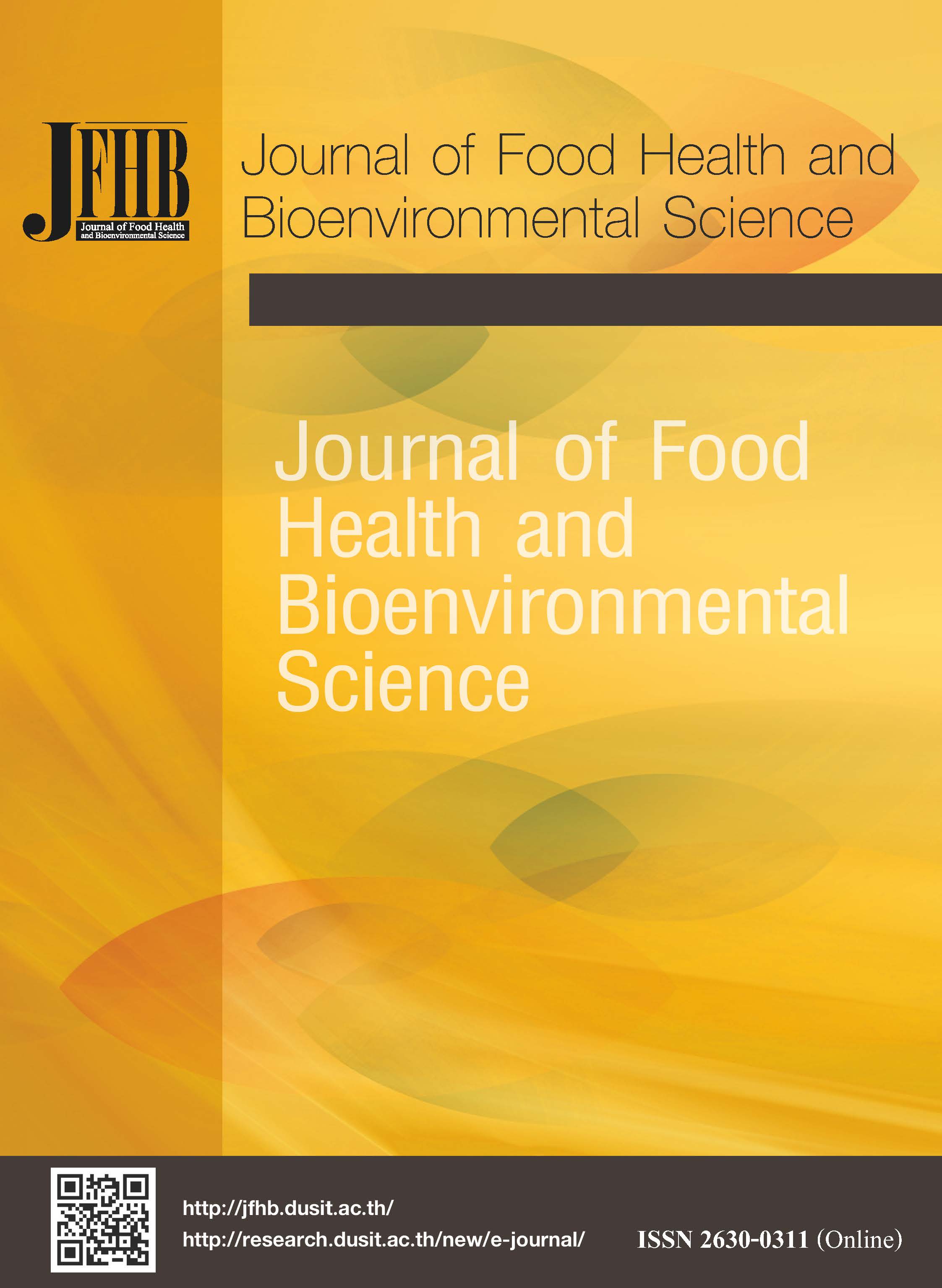Formation of Rice Bran Glycosphingolipids Microemulsion Powders with Vitamin B1, B2, B12, and Folate as Additives for Elderly Food
Keywords:
Glycosphingolipid, Rice bran, Microemulsion Powder, Dietary SupplementAbstract
This research investigated the extraction of glycosphingolipids from rice bran as an emulsifier to form microemulsions with vitamins B1, B2, B12 and folate being added to prepare the emulsion powder as the dietary supplement materials. Rice bran, a low-value agricultural material, was used as raw material for glycosphingolipids extraction using a solvent mixed between dichloromethane and methanol at a ratio of 2:1. The crude extract was observed in physical characteristics. The sphingosine in crude extract was analyzed by spectrophotometer technique. The emulsion was prepared using a mixture of crude extract, Polysorbate 80 and coconut oil. The average particle size of the emulsion was determined using Particle Size Analyzer. The emulsion was made into powder using various drying methods including hot air drying, spray drying and freeze-drying method. The mannan-oligosaccharides were used as an additive to replace the expensive mannitol or the energy-producing sucrose. The distribution property in distilled water of the emulsion powder was determined. The morphology and the surface of the powder emulsion were measured using SEM. The resistance to the imitation of the digestive system and encapsulation efficiency were determined. After extraction, the yield of crude glycosphingolipids extract from rice bran was 20.65%. The crude extract was a clear liquid, slightly yellow, insoluble in water and looks like oil. We found that the crude extract contained sphingosine 22.75 micrograms/gram of crude extract from rice bran. When the emulsion was prepared, the characteristic of the emulsion showed the colloidal solution with a milky white color. The size of the emulsion without vitamins and with vitamins B1, B2, B12, and folate (total 100 ppm) were 70-75 nm and 74.4 -78.1 nm, respectively. This result illustrated that the emulsion was classified as glycosphingolipid microemulsion. The emulsion powder was prepared and we found that the hot air drying and spray drying methods showed a viscous liquid with an oily smell. Whereas the freeze-drying method created the form of a light yellow, odorless and fine emulsion powder. The average particle size of emulsion was 80-100 nm. The solubility test showed that the emulsion powder was able to dissolve up to 300 g/L and 450 g/L at 25°C and 70°C, respectively. The morphological analysis showed that the powder emulsion was quite spherical with a diameter of less than 100 micrometers. In a simulated digestive system test, it was found that glycosphingolipid emulsion releases all vitamins in gastric simulated fluids and simulated small intestinal fluid conditions with values greater than 80%.
References
Arnold, M., Rajagukguk, Y.V., & Gramza-Michałowska, A. (2021). Functional food for elderly high in antioxidant and chicken eggshell calcium to reduce the risk of osteoporosis—a narrative review. Foods, 10(3), 656.
Baik, H.W., & Russell, R.M. (1999). Vitamin B12 deficiency in the elderly. Annual Review of Nutrition, 19, 357-77.
Darole, P.S., Hegde, D.D. & Nair, H.A. (2008). Formulation and evaluation of microemulsion based delivery system for Amphotericin B. AAPS PharmSciTech, 9, 122–128.
Flanagan, J., & Singh, H. (2006). Microemulsions: A potential delivery system for bioactives in food. Critical Reviews in Food Science and Nutrition, 46, 221–237.
Foulger, H.J. (1931). The user of the molisch (α-naphthol) reactions in the study of sugars in biological fluids. Journal of Biological Chemistry, 92, 345–353.
Galia, E., Nicolaides, J.E., Horter, D., Lobenberg, R., Reppas, C., & Dressman, J.B. (1998). Evaluation of various dissolution media for predicting in vivo performance of class I and II drugs. Pharmaceutical Research, 15, 698–705.
Ghasemian, M., & Jahanian, R. (2016). Dietary mannan-oligosaccharides supplementation could affect performance, immunocompetence, serum lipid metabolites, intestinal bacterial populations, and ileal nutrient digestibility in aged laying hens. Animal Feed Science and Technology, 213, 81-89.
Goindi, S., Kaur, A., Kaur, R., Kalra, A., & Chauhan, P. (2016). Nanoemulsions: An emerging technology in the food industry. Emulsions, 3, 651–688.
Guazzotti, S., Pagliano, C., Dondero, F., & Manfredi, M. (2023). Lipidomic profiling of rice bran after green solid–liquid extractions for the development of circular economy approaches. Foods, 12(2), 384.
Kennedy, D.O. (2016). B vitamins and the brain: Mechanisms, dose and efficacy- a review. Nutrients, 8(2), 68.
Kim M.H. & Lee H.J. (2016). Osteoporosis, vitamin C intake, and physical activity in Korean adults aged 50 years and over. The Journal of Physical Therapy Science, 28, 725–773.
Lawrence, M.J., & Rees, G.D. (2000). Microemulsion-based media as novel drug delivery systems. Advanced Drug Delivery Reviews, 45, 89–121.
Paosila, C., Rumpagaporn, P., & Na Jom, K. (2020). Investigation of hydrolyzed ceramide in Thai color rice (Oryza sativa L.) and byproducts. Food Research, 4, 56 – 64.
Saito, T., & Hakomori, S. (1971). Quantitative isolation of total glycosphingolipids from animal cells. Journal of Lipid Research, 12, 257 259.
Subramanian, R., Kalpanadevi, C., & Singh, V. (2018). Influence of milling on the nutritional composition of bran from different rice varieties. Journal of Food Science and Technology, 55(6), 2259–2269.
Talegaonkar, S., Azeem, A., Ahmad, F.J., Khar, R.K., Pathan, S.A., & Khan, Z.I. (2008). Microemulsions: A novel approach to enhanced drug delivery. Recent Patents on Drug Delivery & Formulation, 2, 238-257.
Uchiyama, H., Chae, J., Kadota, K., & Tozuka, Y. (2019). Formation of food grade microemulsion with rice glycosphingolipids to enhance the oral absorption of coenzyme Q10. Foods, 8(10), 502.
Vittal, R.R., & Aswathanarayan, J.B. (2019). Nanoemulsions and their potential applications in food Industry. Frontiers in Sustainable Food Systems, 3, 95.
Downloads
Published
How to Cite
Issue
Section
License

This work is licensed under a Creative Commons Attribution-NonCommercial-NoDerivatives 4.0 International License.








